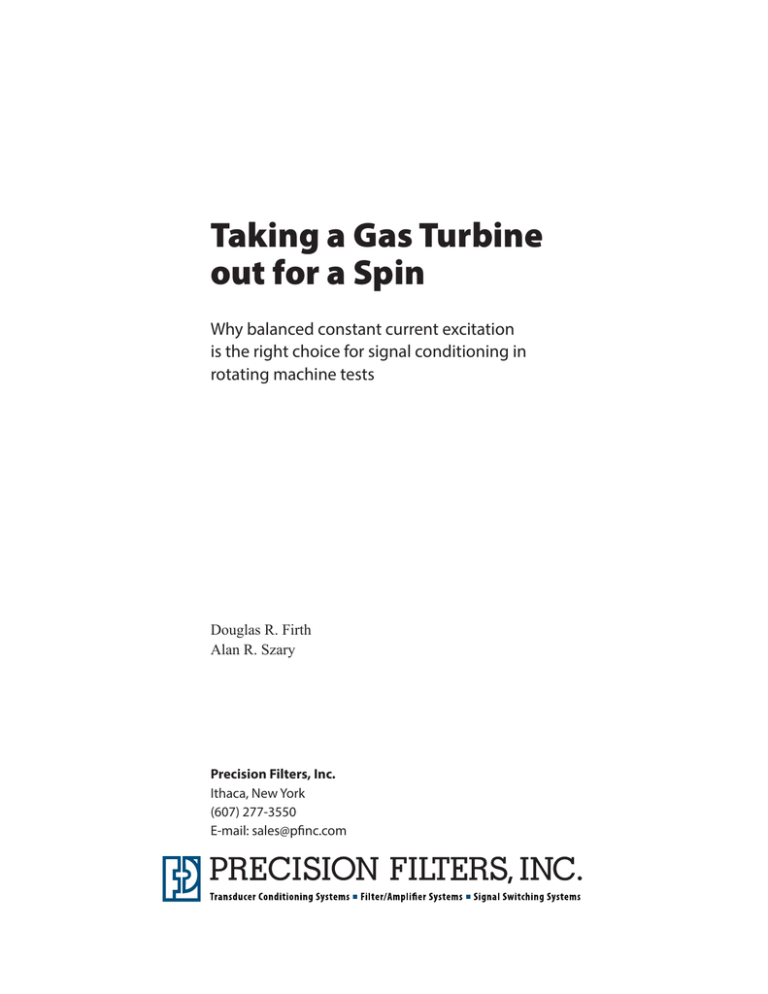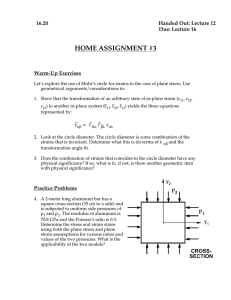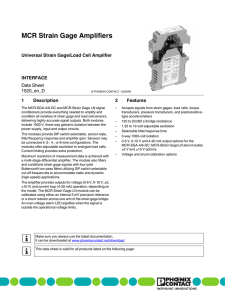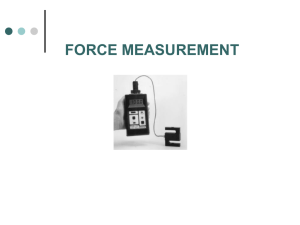Taking a Gas Turbine out for a Spin
advertisement

Taking a Gas Turbine out for a Spin Why balanced constant current excitation is the right choice for signal conditioning in rotating machine tests Douglas R. Firth Alan R. Szary Precision Filters, Inc. Ithaca, New York (607) 277-3550 E-mail: sales@pfinc.com Taking a Gas Turbine out for a Spin 1 Taking a Gas Turbine out for a Spin Why balanced constant current excitation is the right choice for signal conditioning in rotating machine tests Overview Shaft rotational rates to 50,000 rpm … compressor pressures to 500 psi … combustor temperatures to 1,400°C … Even in such extreme conditions, R&D teams working with prototype gas turbine engines can obtain exceptionally accurate measurements of dynamic strain and other performance characteristics. Advanced signal conditioning techniques and equipment enable measurement specialists to eliminate electrostatic noise and to compensate for resistance and temperature variations in test materials, active gages, and lead wires, while recording data from hundreds of sensors at once. These techniques have potential applications for many other types of rotating machines, including steam turbines and jet aircraft engines, and materials testing in any extreme environment. This paper examines the advantages of balanced constant current (BCC) excitation for dynamic strain measurements, compared with the traditional Wheatstone bridge and singleended constant current excitation. BCC excitation uses a pair of matched current sources to excite a strain gage or other transducer and a differential amplifier to measure gage voltage. Douglas R. Firth Alan R. Szary Precision Filters, Inc. Ithaca, New York (607) 277-3550 E-mail: sales@pfinc.com Phone: E-mail 607-277-3550 sales@pfinc.com 2 Taking a Gas Turbine out for a Spin Pioneering Methods for Measuring Strain Thanks to early researchers such as Lord Kelvin and Sir Charles Wheatstone, scientists have known for more than 150 years that the electrical resistance of a wire changes under tension. Capitalizing on this principle, a simple strain gage can be devised by bonding a metallic filament or foil to a test object. Any fractional change in the conductor’s length and electrical resistance reflects strain in the test material. Not surprisingly, some of the first bonded resistance strain gages were developed in the 1930s to study one of the biggest rotary mechanics problems of the time: vibration in airplane engine-propeller systems. The researchers were among the first to contend with the inherent problems of strain gages. Deformations in the propellers were so minute that gain was necessary to amplify the analog signal and obtain accurate resistance measurements. The investigators also discovered that the most suitable electrical alloys were often the most vulnerable to temperature variation and resistance drift. Over the years, various alloys have been developed for high-temperature strain gages, primarily based on a platinum–tungston composition. Fast forward to the gas turbine age. Today’s Challenges Determining dynamic strain characteristics is fundamental to validating gas turbine engine designs and establishing safe operating margins. Dynamic strain measurements define stress and deflection limits, casing clearances, and onset of high cycle fatigue. Also, careful analysis of strain ratios from gages strategically positioned along the fan, compressors, and turbines can be used for further modeling, including the detection of potential problems with vibration. In a typical test setup, special high-temperature strain gages are welded, cemented, or flame sprayed onto a test article. A slip ring allows for connection of the signal conditioning instrumentation to gages on the rotating part of the engine. For safety and environmental reasons, lead wires or cables run from the gas turbine being tested to a signal conditioner in a remotely located control room. The signal conditioner excites the strain gages and measures dynamic resistance, which is proportional to the dynamic strain. Phone: Web Site: 607-277-3550 www.pfinc.com Taking a Gas Turbine out for a Spin 3 Obtaining accurate measurements from strain gages exposed to intense heat and vibration is problematic for a number of reasons: • Gage insulation breaks down, allowing resistive leakage to ground. • Strain gages fatigue or crack, resulting in shorts to the test material. • Lead wires—made of alloys that won’t break, melt, or corrode—have high electrical resistances that surge dramatically under typical startup temperature escalations. • Engine vibrations cause certain types of lead wires to output their own electrical noise signals. • Large levels of electrostatic and electromagnetic noise can be present, particularly if the engine is used as a generator of electricity, and are difficult to shield because of how leads must be routed. • Slip rings are a source of modulated resistance and contact noise. Slip ring assemblies offer a limited number of contact points, limiting the number of strain gages or other sensors that can be measured on the rotor. Two-wire hookups are used to maximize the number of sensors for a given slip ring. A variety of approaches can be used to amplify, filter, and capture the signals coming from the strain gages. Wheatstone Bridge The Wheatstone bridge is the most common signal conditioning method for strain gage measurements. Figure 1 shows a two-wire Wheatstone bridge circuit that may be used for single-gage dynamic strain measurements. This 19th-century technique determines the gage element’s unknown electrical resistance by balancing the voltage input to two branches of the bridge circuit, one connected to the strain sensor. Under strain, the branch connected to the gage becomes unbalanced, and the voltage output can be used to infer the mechanical strain on the gage. For dynamic strain measurement, an ACcoupled differential amplifier removes DC unbalance caused by lead wire resistance. Measurement sensitivity is defined as the change in circuit output voltage relative to changes in gage resistance. Phone: E-mail 607-277-3550 sales@pfinc.com Taking a Gas Turbine out for a Spin Electrostatic Noise Source REXT EN Exc CNH CNL CNSH RG REXT Signal Conditioner Interface eIN – Figure 1: Two-Wire Wheatstone Bridge Connection Although the AC coupling removes DC lead resistance errors, measurement sensitivity errors are a more troublesome aspect of the two-wire Wheatstone bridge setup. Common lead wire and cable resistances range from .006 ohms per foot, for standard 18-gauge wire, to as high as 10 ohms per foot for temperature-resistant wire used in extremely hot test environments such as turbine engine compressors. Figure 2 illustrates the falling off of measurement sensitivity in a 350-ohm gage, conditioned by a single-arm Wheatstone bridge, as the electrical resistance in a lead wire REXT increases. If the lead resistance is known, increased amplification—or channel gain—can be used to compensate for the loss. However, if the lead resistance is not known or drifts with temperature, the lead wire becomes a source of measurement uncertainty. Normalized Measurement Sensitivity for 350 Ω Gage vs. Cable Resistance, REXT 1.1 1.0 0.9 Normalized Measurement Sensitivity 4 Constant Current 0.8 Single Arm Wheatstone 0.7 0.6 0.5 0.4 0.3 0.2 0.1 0 0 50 100 150 200 250 300 REXT (Ohms) 350 400 450 500 Figure 2: Normalized Measurement Sensitivity vs. REXT Phone: Web Site: 607-277-3550 www.pfinc.com Taking a Gas Turbine out for a Spin 5 Wheatstone Bridge Pros • The Wheatstone bridge amplifier is commonly used and is readily available in most test labs. • In some test situations where the environment is well controlled, this standard bridge circuit offers adequate sensitivity and accuracy. Cons • Lead wire resistance causes a decline in gage sensitivity. • Lead wire resistance is highly sensitive to temperature variations throughout a test, representing an unacceptable measurement error. • Attempting to determine the lead resistance for every channel in a large, complex test setup is time consuming, costly, and prone to errors. • The bridge connection is characteristically unbalanced and sensitive to electrostatic noise pickup—with no protection afforded by the signal conditioner’s differential amplifier. • Inherent in the Wheatstone bridge circuit is a 50% gage signal loss— requiring twice the channel gain and resulting in more input noise and a worsening of the overall signal-to-noise ratio. • The Wheatstone bridge circuit is intolerant of insulation breakdown— leading to data loss during critical testing. Single-ended Constant Current Excitation For single-gage dynamic measurements, single-ended constant current excitation is preferred to the Wheatstone bridge because measurement sensitivity is unaffected by lead wire resistance. As the name suggests, a single-ended constant current source excites the strain gage. (See Figure 3.) Because the current is held constant, gage resistance fluctuations are converted directly to voltage fluctuations independent of lead wire resistance. When only dynamic data is required, the lead wires can be AC coupled to the differential amplifier, resulting in a simple two-wire connection with known measurement sensitivity. Phone: E-mail 607-277-3550 sales@pfinc.com 6 Taking a Gas Turbine out for a Spin Power dissipation from the gage—in the form of heat—is often given primary consideration when setting gage excitation levels. Circuit analysis shows that at any given gage power dissipation level, constant current excitation provides twice the measurement sensitivity of the Wheatstone bridge and significantly improves signal-to-noise ratios. +V Constant Current Supply Electrostatic Noise Source REXT EN CNH CNL CNSH RG eIN + + – eOUT SE Signal Conditioner Interface REXT Figure 3: Single-Ended Constant Current Excitation Circuit Single-ended Constant Current Excitation Pros • Measurement sensitivity is unaffected by lead wire resistance. • Gage resistance fluctuations are converted directly to voltage fluctuations with no need for ballast or completion resistors. • At a given gage power dissipation, single-ended constant current excitation offers twice the sensitivity of a Wheatstone bridge. Cons • As with the Wheatstone bridge, single-ended constant current is unbalanced and sensitive to electrostatic noise pickup—with no protection afforded by the signal conditioner’s differential amplifier. • Like the Wheatstone bridge, the single-ended constant current circuit is intolerant of insulation breakdown and direct shorts, which can lead to the loss of critical data during testing. Phone: Web Site: 607-277-3550 www.pfinc.com Taking a Gas Turbine out for a Spin 7 Balanced Constant Current Dynamic Strain Balanced constant current (BCC) excitation uses a pair of matched current sources to excite the gage and a differential amplifier to measure gage voltage. This balanced approach to gage excitation offers the benefits of a single-ended constant current source—measurement sensitivity and immunity to lead wire resistance changes—with additional advantages. (See Figure 4.) With respect to noise sources, the two connections to the differential amplifier are balanced, both physically and electrically. Judicious selection of cables and hookup techniques will ensure that noise pickups from the two balanced inputs are nearly equal and, consequently, suppressed by the common-mode rejection (CMR) of the differential amplifier. The balanced circuitry also provides a tolerance of certain gage fault conditions, such as deterioration of the gage wiring insulation. In fact, correct strain signals can be measured even with a short to ground on either gage terminal. To illustrate the effects of noise coupling, Figures 1, 3, and 4 all show an electrostatic noise source. Notice in Figure 4 that a twisted/shielded pair is run between the amplifier and the active gage and parallel to the noise source. The signal cable picks up electrostatic interference from the hostile noise source primarily when the center conductors extend beyond the shield. To the extent that the cable is balanced with respect to the electrostatic noise source, the pickup will be the same in both input leads (eIN+≈eIN-). The differential input reduces the noise common to the inputs, substantially reducing output noise (eOUT BCC). V+ IEXC Electrostatic Noise Source REXT EN eIN + CNH CNL RIN CNSH + – RG eOUT BCC RIN REXT eIN – Signal Conditioner Interface IEXC V– Figure 4: Balanced Constant Current Excitation Circuit Phone: E-mail 607-277-3550 sales@pfinc.com 8 Taking a Gas Turbine out for a Spin Figure 5 is the circuit diagram for an actual BCC solution implemented by Precision Filters, Inc. using one of the company’s proprietary signal conditioning cards. Two matched current sources are arranged in a push–pull configuration. One feeds current to the gage; the other draws current from the gage. Provided the two current sources are well matched and the floating gage is connected to the input through a twisted/shielded pair, the circuit will be both physically and electrically balanced and offer excellent noise immunity. This balanced circuit has twice the signal compliance range of a ground referred single-ended circuit, because the gage DC voltage is symmetrical about the bipolar power supply. For dynamic measurements, the switches can be arranged so that SW1 is in a two-wire mode and coupled for AC input. For static strain measurements, a four-wire mode with high-impedance sense lines connects the differential amplifier directly to the gage terminals, making DC measurements insensitive to lead resistance. AC Test Current DC Drive SW2 IDRIVE SW1 RSENSE IDRIVE Monitor +Signal Guard RGAGE Shield Gage Short/Open Detect Input Amp –Signal ISINK SW1 RSENSE ISINK Monitor SW2 DC Sink AC Test Current Figure 5: BCC Excitation Circuit Diagram Phone: Web Site: 607-277-3550 www.pfinc.com Taking a Gas Turbine out for a Spin 9 Figure 6 demonstrates the superiority of BCC excitation for suppression of electrostatic noise versus a single-ended excitation circuit. The graph plots noise pickup eOUT BCC and eOUT SE versus frequency for RG = 1000Ω, CNH = 22pF, and CNL = 20pF. With increasing frequency, electrostatic coupling increases by 20 dB per decade. For this example, the balanced design results in 26 dB less noise pickup, compared with the single-ended design. The reduction of noise pickup in the balanced circuit is largely dependent on the match of stray capacitors CNH and CNL. The effectiveness of the shield termination will determine whether CNSH couples noise to the shield. Noise can be pronounced with improperly terminated shields or in extreme test conditions where long cable runs are necessary. In the model in Figure 4, noise coupling from the shield to the center conductors is a potential issue because the coupling capacitance is approximately 40pF per foot. Fortunately, the built-in CMR of the balanced design rejects the induced noise. Electrostatic Coupling for Balanced vs. Single-Ended Excitation Circuits –20 –40 SNR = 0 dB Noise Coupling (dB) 1 mV Signal –60 –80 Balanced –100 Single-Ended –120 0.1 1 10 100 Log Frequency (kHz) Figure 6: Electrostatic Noise Coupling for Balanced vs. Single-Ended Excitation Precision Filters, Inc. of Ithaca, New York invented BCC technology. The company’s signal conditioning products remain the standard for obtaining highly accurate and validated output data. BCC is significantly less susceptible to noise pickup than Wheatstone bridge and single-ended constant current conditioning. The push–pull configuration maintains accurate gage current, even with insulation breakdown or a short on either of the gage terminals— preventing loss of critical data. Phone: E-mail 607-277-3550 sales@pfinc.com 10 Taking a Gas Turbine out for a Spin Balanced Constant Current Excitation Pros • Immunity to lead resistance, with no decrease in gage sensitivity at any temperature • Immunity to certain gage fault conditions, such as deterioration of lead wire insulation, that result in a direct short to the test subject • Less susceptibility to electrostatic noise—typically 50 to 100 times less electrostatic noise pickup • Wider current source compliance, allowing larger gage and lead resistance Cons • The initial cost of the more sophisticated signal conditioning equipment used for BCC excitation can be more expensive than traditional Wheatstone bridge and single-ended constant current setups. Verification of Cable and Sensor Health The best signal conditioner is of little value if the measurement system fails during a test. Discovering a faulty gage or a defective cable after the test is too late. Lost data can never be recovered, and often it is impossible, or too costly, to repeat a test. At the same time, the harsh conditions of gas turbine research tax the most durable materials and rugged equipment. A simple, fail-safe protocol for verifying the health of all gages, lead wires, and cabling is essential to any successful measurement system, but particularly for destructive tests. The Precision Filters 28000 Signal Conditioning System has built-in hardware and software that allow the test measurement team to quickly and easily run a series of automated sensor, circuit, and cable run checks. Precision Filters also makes available a series of signal conditioning cards that facilitate real-time monitoring of complicated wiring schemes, measure and report cable roll-off, and detect insulation leakage. Phone: Web Site: 607-277-3550 www.pfinc.com Taking a Gas Turbine out for a Spin 11 System Testing, Calibration, & Life Cycle Costs Yearly calibration of signal conditioning equipment is the minimum basis for defendable test data. Most test measurement departments and research facilities require additional validation and documentation of performance specifications. Continual setup and teardown take a toll on sensitive circuitry and demand a rigorous approach to system verification. Yet verification protocols are seldom followed if the inconvenience and cost outweigh the perceived benefits. The Precision 28000 self-test subsystem can conduct comprehensive yearly calibrations and on-site pretest go/no-go diagnostics at the push of a button—without removing the system from the equipment rack. The life cycle cost of a test measurement system is the total cost of ownership. This includes the purchase price of the components; installation; the time required for setup, teardown, and reconfiguration; acceptance testing; maintenance; and calibration. Operation and maintenance costs, notably staff time, generally exceed acquisition costs, particularly with poor-quality equipment. An often overlooked cost is the price of bad data—or no data. The cost of a failed test, even one gas turbine engine trial, can be immense. The Precision Filters 28000 system significantly reduces life cycle costs and provides automated self-diagnostic and calibration capabilities that can reduce or eliminate component or system failures. Summary Balanced constant current excitation offers the test measurement team four main advantages: 1) significantly less susceptibility to electrostatic noise; 2) immunity to certain gage faults, including direct shorts to the test subject; 3) wide current source compliance to accommodate large gage + cable resistance; 4) insensitivity to initial lead wire resistance and to fluctuation of lead wire resistance with temperature. Precision Filters of Ithaca, New York invented BCC technology. The company’s 28000 Signal Conditioning System and conditioner cards, designed specifically for testing rotating machines, offer flexible, reliable, and verifiable solutions for measuring dynamic strain gages and a wide range of other transducers. Phone: E-mail 607-277-3550 sales@pfinc.com 12 Taking a Gas Turbine out for a Spin Precision Filters, Inc. On the New Frontiers of Precision Precision Filters, Inc. (PFI) has worked closely with the world’s leading manufacturers and test facilities for 40 years. The company has played a key role in the evolution of advanced methods for measuring dynamic and static strain, pressure, vibration, acceleration, velocity, and displacement—even under the most exacting test conditions. PFI products include analog signal conditioning, filter/amplifier, and signal switching systems. The company’s Precision 28000 Signal Conditioning System offers a unique suite of signal conditioning cards designed specifically for the demanding requirements of turbine and other rotating machine tests. PFI’s proprietary balanced constant current and constant voltage excitation give the measurement team considerable flexibility in designing trials using any type of strain or pressure gage, bridge-type transducer, load cell, accelerometer, or resistance-temperature detector. Available in 32-, 64-, and 128-channel chassis configurations, the Precision Filters 28000 provides a scalable, turnkey solution for measurement systems of any magnitude or complexity. To learn more about BCC excitation and signal conditioning for turbine/ rotating machine testing, ask for these publications: • White Paper: Balanced Constant Current Excitation for Dynamic Strain Measurements • Application Brief: Signal Conditioning for Gas Turbine Engine Testing • Technical Note TN-1: Measuring Dynamic Strain on Gas Turbine Blades Trademarks Balanced Constant Current and BCC are trademarks of Precision Filters, Incorporated. Phone: Web Site: 607-277-3550 www.pfinc.com Precision Filters, Inc. Ithaca, New York (607) 277-3550 E-mail: sales@pfinc.com


